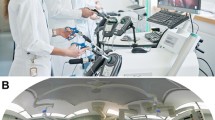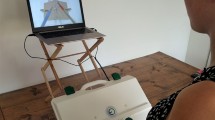Abstract
Background
The aim of this work is to present the face, content, and construct validation of the virtual immersive operating room simulator (VIORS) for procedural training of surgeons’ laparoscopic psychomotor skills and evaluate the immersive training experience.
Methods
The VIORS simulator consists of an HMD Oculus Rift 2016 with a visor on a 1080 × 1200 pixel OLED screen, two positioning sensors with two adapted controls to simulate laparoscopic instruments, and an acrylic base to simulate the conventional laparoscopic setup. The immersion consists of a 360° virtual operating room environment, based on the EndoSuite at Hospital Infantil de Mexico Federico Gomez, which reproduces a configuration of equipment, instruments, and common distractions in the operating room during a laparoscopic cholecystectomy procedure. Forty-five surgeons, residents, and medicine students participated in this study: 27 novices, 13 intermediates, and 5 experts. They completed a questionnaire on the realism and operating room immersion, as well as their capabilities for laparoscopic procedural training, scored in the 5-point Likert scale. The data of instrument movement were recorded and analyzed using 13 movement analysis parameters (MAPs). The experience during training with VIORS was evaluated through NASA-TLX.
Results
The participants were enthusiastic about the immersion and sensation levels of the VIORS simulator, with positive scores on the realism and its capabilities for procedural training using VIORS. The results proved that the VIORS simulator was able to differentiate between surgeons with different skill levels. Statistically significant differences were found in nine MAPs, demonstrating their construct validity for the objective assessment of the procedural laparoscopic performance. At cognitive level, the inversion experience proves a moderate mental workload when the laparoscopic procedure is carried out.
Conclusion
The VIORS simulator has been successfully presented and validated. The VIORS simulator is a useful and effective device for the training of procedural laparoscopic psychomotor skills.


Similar content being viewed by others
References
Derossis AM, Fried GM, Abrahamowicz M, Sigman HH, Barkun JS, Meakins JL (1998) Development of a model for training and evaluation of laparoscopic skills. Am J Surg. https://doi.org/10.1016/s0002-9610(98)00080-4
Arts EEA, Leijte E, Witteman BPL, Jakimowicz JJ, Verhoeven B, Botden SMBI (2019) Face, content, and construct validity to the take-home eosim augmented reality laparoscopy simulator for basic laparoscopic task. J Laparoendosc Adv Surg Tech A. https://doi.org/10.1089/lap.2019.0070
Reznick RK (1993) Teaching and testing technical skills. Am J Surg. https://doi.org/10.1016/s0002-9610(05)80843-8
Huber T, Paschold M, Hansen C, Wunderling T, Hauke L, Kneist W (2017) New dimensions in surgical training: immersive virtual reality laparoscopic simulation exhilarates surgical staff. Surg Endosc. https://doi.org/10.1007/s00464-017-5500-6
Huber T, Paschold M, Hansen C, Lang H, Kneist W (2018) Artificial versus video-based immersive virtual surroundings: analysis of performance and user’s preference. Surg Innov. https://doi.org/10.1177/1553350618761756
Ganni S, Li M, Botden SMB, Nayak SR, Ganni BR, Rutkowski AF, Goossens RHM, Jakimowicz J (2020) Virtual operating room simulation setup (VORSS) for procedural training in minimally invasive surgery – a Pilot study. Indian J Surg. https://doi.org/10.1007/s12262-020-02131-z
Healey AN, Sevdalis N, Vicent CA (2006) Measuring intra-operative interference from distraction and interruption observed in the operating theatre. Ergonomics. https://doi.org/10.1080/00140130600568899
Zheng B, Martinee DV, Cassera MA, Swanström LL (2008) A quantitative study of disruption in the operating room during laparoscopic antireflux surgery. Surg Endosc. https://doi.org/10.1007/s00464-008-0017-7
Wiegmann DA, ElBardissi AW, Dearani JA, Daly RC, Sundt TM III (2007) Disruptions in surgical flow and their relationship to surgical error: an exploratory investigation. Surgery. https://doi.org/10.1016/j.surg.2007.07.034
Sankaranarayanan G, Li B, Manser K, Jones SB, Jones DB, Schwaitzberg S, Cao CG, De S (2016) Face and construct validation of a next generation virtual reality (Gen2-VR). Surg Endosc. https://doi.org/10.1007/s00464-015-4278-7
Arikatla VS, Ahn W, Sankaranarayanan G, De S (2014) Towards virtual FLS: development of a peg transfer simulator. Int J Med Robot. https://doi.org/10.1002/rcs.1534
Huber T, Wunderling T, Paschold M, Lang H, Kneist W, Hansen C (2018) Highly immersive virtual reality laparoscopy simulation: development and future aspects. Int J Comput Assist Radiol Surg. https://doi.org/10.1007/s11548-017-1686-2
Frederiksen JG, Sørensen SMD, Konge L, Svendsen MBS, Nobel-Jørgensen M, Bjerrum F, Andersen SAW (2020) Cognitive load and performance in immersive virtual reality versus conventional virtual reality simulation training of laparoscopic surgery: a randomized trial. Surg Endosc. https://doi.org/10.1007/s00464-019-06887-8
Pérez-Escamirosa F, Medina-Alvarez D, Ruiz-Vereo E, Ordorica-Flores RM, Minor-Martínez A, Tapia-Jurado J (2020) Inmersive virtual operating room simulation for surgical resident education during COVID-19. Surg Innov. https://doi.org/10.1177/15533506209521832020
Feldman LS, Sherman V, Fried GM (2004) Using simulators to assess laparoscopic competence: ready for widespread use? Surgery. https://doi.org/10.1016/S0039-6060(03)00155-72004
Sánchez-Margallo JA, Sánchez-Margallo FM, Oropesa I, Enciso S, Gómez EJ (2017) Objective assessment based on motion-related metrics and technical performance in laparoscopic suturing. Int J Comput Assist Radiol Surg. https://doi.org/10.1007/s11548-016-1459-3172017,Jul
Escamirosa FP, Flores RMO, García IO, Vidal CR, Martínez AM (2015) Face, content, and construct validity of the EndoViS training system for objective assessment of psychomotor skills of laparoscopic surgeons. Surg Endosc. https://doi.org/10.1007/s00464-014-4032-618,Dec17
Chmarra MK, Grimbergen CA, Jansen F-W, Dankelman J (2010) How to objectively classify residents based on their psychomotor laparoscopic skills? Minim Invasive Ther Allied Technol. https://doi.org/10.3109/13645700903492977
Chmarra MK, Klein S, de Winter JCF, Jansen FW, Dankelman J (2010) Objective classifcation of residents based on their psychomotor laparoscopic skills. Surg Endosc. https://doi.org/10.1007/s00464-009-0721-y
Oropesa I, Sánchez-González P, Chmarra MK, Lamata P, Pérez-Rodríguez R, Jansen FW, Dankelman J, Gómez EJ (2014) Supervised classification of psychomotor competence in minimally invasive surgery based on instruments motion analysis. Surg Endosc. https://doi.org/10.1007/s00464-013-3226-7
Arora S, Sevdalis N, Nestel D, Woloshynowych M, Darzi A, Kneebone R (2010) The impact of stress on surgical performance: a systematic review of the literature. Surgery. https://doi.org/10.1016/j.surg.2009.10.007
Aydodeji ID, Schijven M, Jakimowicz J, Greve JW (2007) Face validation of the Simbionix LAP Mentor virtual reality training module and its applicability in the surgical curriculum. Surg Endosc. https://doi.org/10.1007/s00464-007-9219-7
Schreuder HWR, van Dongen KW, Roeleveld SJ, Schijven MP, Broeders IAMJ (2009) Face and construct validity of virtual reality simulation of laparoscopic gynecologic surgery. Am J Obstet Gynecol. https://doi.org/10.1016/j.ajog.2008.12.030
Alsalamah A, Campo R, Tanos V, Grimbizis G, Van Belle Y, Hood K, Pugh N, Amso N (2017) Face and content validity of the virtual reality simulator ‘Scan Trainer.’ Gynecol Surg. https://doi.org/10.1186/s10397-017-1020-6
Nayar SK, Musto L, Fernandez R, Bharathan R (2019) Validation of virtual reality laparoscopic appendicectomy simulator: a novel process using cognitive task analysis. J Med Sci. https://doi.org/10.1007/s11845-018-1931-x
Sessa L, Perrenot C, Xu S, Hubert J, Bresler L, Brunaud L, Perez M (2018) Face and content validity of XperienceTM Team Trainer:bed-side assistant trainning simulator for robotic surgery. Updates Surg. https://doi.org/10.1007/s13304-017-0509-x
Kawaguchi K, Egi H, Hattori M, Sawada H, Suzuki T, Ohdan H (2014) Validation of a novel basic virtual reality simulator, the LAP-X, for training basic laparoscopic skills. Minim Invasive Ther Allied Technol. https://doi.org/10.3109/13645706.2014.903853
Pérez-Escamirosa F, Chousleb-Kalach A, Hernández-Baro MD, Sánchez-Margallo JA, Lorias-Espinoza D, Minor-Martínez A (2016) Construct validity of a video-tracking system based on orthogonal cameras approach for objective assessment of laparoscopic skills. Int J Comput Assist Radiol Surg. https://doi.org/10.1007/s11548-016-1388-12016
Oropesa I, Sánchez-González P, Chmarra MK, Lamata P, Fernández A, Sánchez-Margallo JA, Jansen FW, Dankelman J, Sánchez-Margallo FM, Gómez EJ (2013) EVA: laparoscopic instrument tracking based on endoscopic video analysis for psychomotor skills assessment. Surg Endosc. https://doi.org/10.1007/s00464-012-2513-z
Oropesa I, Chmarra MK, Sánchez-González P, Lamata P, Rodrigues SP, Enciso S, Sánchez-Margallo FM, Jansen FW, Dankelman J, Gómez EJ (2013) Relevance of motion-related assessment metrics in laparoscopic surgery. Surg Innov. https://doi.org/10.1177/1553350612459808
Wetzel CM, Kneebone RL, Woloshynowych M, Nestel D, Moorthy K, Kidd J, Darzi A (2006) The effect of stress on surgical performance. Am J Surg. https://doi.org/10.1016/j.amjsurg
Hart SG (1998) Development of NASA-TLX (Task Load Index): results of empirical and theoretical research. Adv Psychol Res. https://doi.org/10.1016/S0166-4115(08)62386-9
Hart SG (2006) NASA-Task Load Index (NASA-TLX); 20 years later. Proc Hum Factors Ergon Soc Annu Meet. https://doi.org/10.1177/154193120605000909
Acknowledgements
The authors would like to thank all medical students, residents and surgeons for their enthusiastic and kindly participation in this study. Special thanks to David Medina-Álvarez from Centro Médico Nacional 20 de Noviembre ISSSTE, for his technical assistance in the organization and recruitment of all participants with the VIORS laparoscopic simulator in the study.
Funding
This work has been carried out with the support of the UNAM-DGAPA-PAPIME program with project number PE217020, and UNAM-DGAPA-PAPIIT program with Project Number IT200820.
Author information
Authors and Affiliations
Corresponding author
Ethics declarations
Disclousure
Drs. Fernando Pérez-Escamirosa, Damaris Areli García-Cabra, José Ricardo Ortiz-Hernández, Salvador Montoya-Alvarez, Eduardo Alfredo Ruíz-Vereo, Ricardo Manuel Ordorica-Flores, Arturo Minor-Martínez, and Jesus Tapia-Jurado have no conflicts of interest or financial ties to disclose.
Informed consent
Informed consent was obtained from all individual participants included in this study.
Additional information
Publisher's Note
Springer Nature remains neutral with regard to jurisdictional claims in published maps and institutional affiliations.
Rights and permissions
Springer Nature or its licensor (e.g. a society or other partner) holds exclusive rights to this article under a publishing agreement with the author(s) or other rightsholder(s); author self-archiving of the accepted manuscript version of this article is solely governed by the terms of such publishing agreement and applicable law.
About this article
Cite this article
Pérez-Escamirosa, F., García-Cabra, D.A., Ortiz-Hernández, J.R. et al. Face, content, and construct validity of the virtual immersive operating room simulator for training laparoscopic procedures. Surg Endosc 37, 2885–2896 (2023). https://doi.org/10.1007/s00464-022-09797-4
Received:
Accepted:
Published:
Issue Date:
DOI: https://doi.org/10.1007/s00464-022-09797-4




